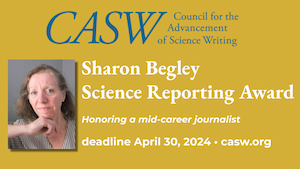By Charlotte Huff
Jeanne Erdmann credits a $20,000 Idea Grant in 2011 with enabling her and co-founder Siri Carpenter to take their recently launched website The Open Notebook to the next level. Along the way, the process of writing and revising that first grant helped them to better explain how the money could make a significant difference for their online science writing resource, which has since garnered subsequent grants from NASW and other organizations. “Every time you write a grant, it really helps you to crystalize your idea,” said Erdmann, who spoke on a panel outlining the logistics and benefits of pursuing the funding.
Funded through the Authors Coalition, the awards have totaled nearly $430,000 since 2011, with slightly more than one in four applicants receiving at least some money, according to data presented by Jeffrey Perkel, who chairs the NASW grants committee.
Applicants don’t have to be members. But to be eligible, the proposal must demonstrate the project’s breadth of purpose in furthering the advancement of either science writers or science writing. The grants are not designed for individual-focused projects, such as funding research for a personal book project, the panel leaders stressed.
When submitting, applications should highlight how the money would assist the endeavor, whether that’s launching a website or making a science writing conference feasible, among other possibilities, said Perkel and prior chair Robin Lloyd. “Specificity is helpful here,” Perkel said.
The related budget amount also should be broken down. Don’t just request $5,000 for travel costs, without outlining the amounts needed for train tickets, hotels and other elements, Perkel said. Be prepared to offer a lower-cost budget in case a smaller grant is awarded. The committee recently has been paying heightened attention to whether the project can sustain momentum over the longer haul, Perkel said. “If you ask for $10,000 to get a website off the ground, what are you going to do when that grant runs out?”
The current maximum limit is $40,000, but any grant of more than $5,000 must weather a two-step process. After the grants committee signs off, it also must be approved by the board’s executive committee.
The pool of available funds has ranged as high as $100,000 in some years, but this year will be limited to roughly $30,000, Perkel said. The stats to date: 127 applications received since 2011; 41 approved by committee; and 36 ultimately awarded.
One of those grants, for $43,000, allowed a group of online science writers to put their discussions about the trials and triumphs of the writing life onto paper, said Thomas Hayden, co-editor of the resulting book, The Science Writers' Handbook: Everything You Need to Know to Pitch, Publish, and Prosper in the Digital Age. “It changed from a conversation to a project,” he said.
The panel leaders encouraged anyone interested in applying to ask questions as they develop their proposal. For more details and examples, including proposals, see this page. Any questions can be sent to grants@nasw.org; the next deadline is Nov. 4.
.png)

